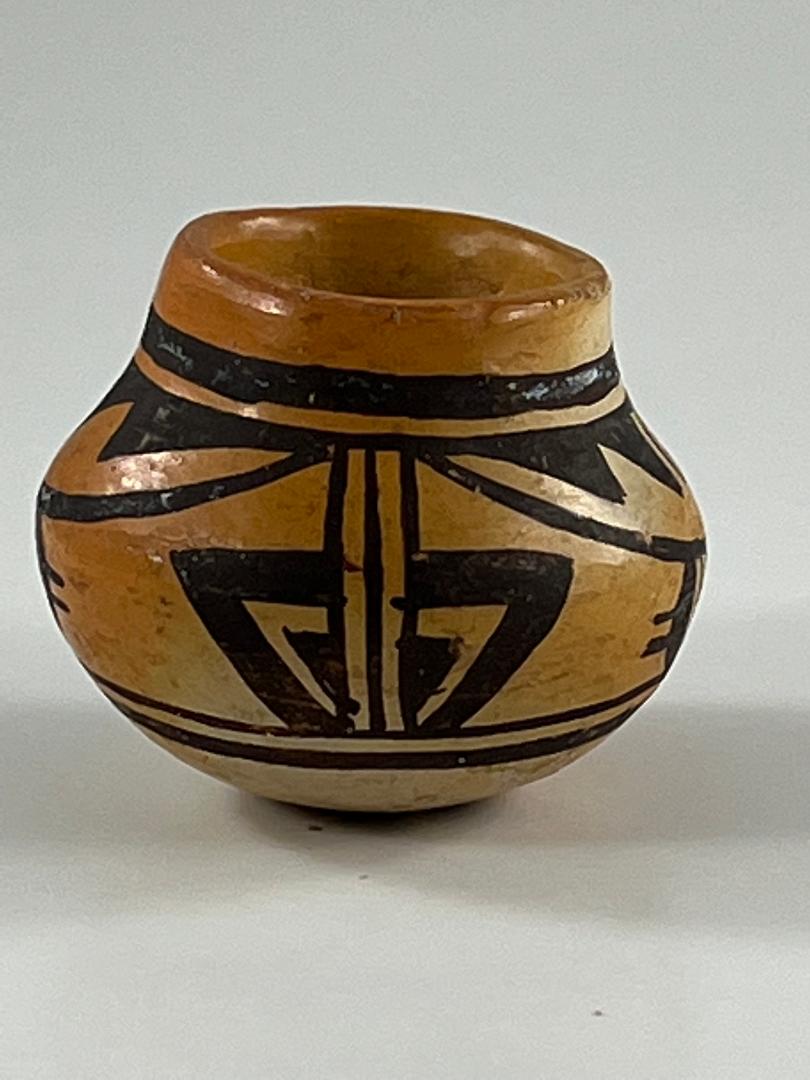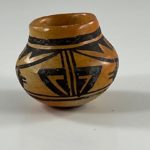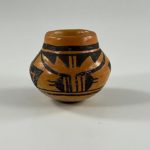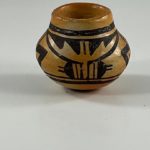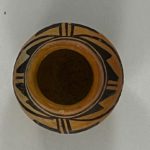This is a nicely done but –at first glance– is not an extraordinary miniature Tewa-Hopi pot. What makes it unusual is its maker: Beatrice Nampeyo.
Mary Ellen and Laurence Blair published a genealogy chart (1999:262-263) indicating that Annie (Nameyo’s oldest child) and her husband Willie Healing had 8 children, two of whom died as infants. In their text, however, they say that Annie and Willie had five children in 12 years, Rachael being the oldest and Beatrice being the last. Beatrice was born in 1912 and died when she was about 30 in 1942 (1999:184). She probably made pottery for about half her life and only a few examples of her pottery known to me, four now in this collection. Beatrice “was briefly involved with pottery, but moved away after marrying. The date of her death is uncertain…” (Dillingham, 1994:43). There is a picture of Beatrice ca 1930 in Dillingham.
I have spoken with family members about her and, sadly, not much is known. Descendant Priscilla told me that Beatrice used to sign pots for Annie. (See Appendix E.) When Rachael Sahmie visited my home in 2008, it was the first time she had seen a pots by this ancestor (2002-08 and 2005-04). Thus, though miniature (and one damaged) pots 2020-13 and 2020-14 are significant additions to this collection.
Form: This jar is just larger than a pinch pot and is well-formed with a somewhat thicker bottom and substantial walls. The inside walls are somewhat rough and striated, perhaps from Beatrice’s fingers. The pot has a short neck and is stone polished both on the exterior and on the inside of the neck. A section of the bottom and one side of the jar are highlighted by golden blushing from the outdoor firing.
Design:
The design is monochromatic black. As with her grandmother Nampeyo, Beatrice placed thick-over-thin framing lines above the decoration, with decorative elements pendant from the thin line. Below the design is another set of framing lines, the order reversed.
The jar carries two designs, alternately each repeated twice. The first design is built around three parallel lines that bridge between the upper and lower framing lines, forming what I call a “two-lane highway.” A small, solid, right triangle is set against the edge of this highway, its right angle uppermost. After a small unpainted gap, a thick line enclosed the small triangle, its triangular shape mimicking the small triangle beneath. Since this same pattern occurs on both sides of the central two-lane highway, the overall pattern is of a thick line in the shape of a truncated triangle enclosing a similar, smaller form.
The second design is more elaborate. Starting on either side of the two-lane highway of the first design where it touches the upper framing lines, two thin swags curve down away from each other, almost touching the swags originating on the other side of the jar. Just before these swags lines collide, they drop 0.4375-inches straight to the framing line below, leaving a 0.125-inch gap between. These swags are the framework around which additional design elements are set.
Pendant from the thin framing line around the neck and encompassed by swags, are two sets of two solid triangles pointing downward. Between the sets is a single short line that emerges from the framing line and also points downward to the gap between the swags. These triangles are casually-drawn with their right angle facing the central short line. Exterior to the 0.4375-inch lines that form the gap at the lower end of the swags are two additional parallel lines and, together, these lines form a two-lane “highway” on either side of the gap. A solid hill is external to and based on this highway and at its apex the hill sprouts two parallel lines. This is a standard Nampeyo element that I list as a “gumdrop with whiskers” in Appendix E.
The design on this miniature jar is both more original and complex than I understood at first glance. It suggests that Beatrice was a potter of considerable imagination and skill.

